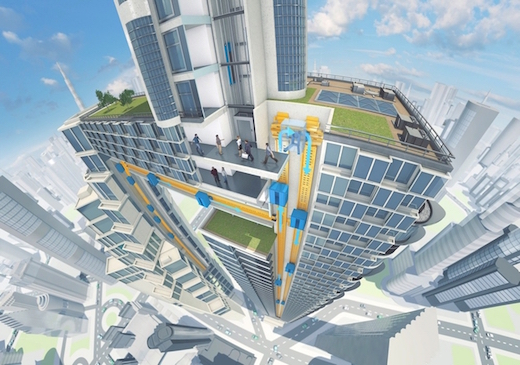
With the new elevator proposed by ThyssenKrupp, elevators as we know them could be a thing of the past. While the invention of the elevator made the skyscraper possible, this new elevator could once again redefine the urban architecture and design. The new elevator would be able to go up and down, as well as side to side, and do so without any cables or pulleys, or the need to wait for the elevator in case you just missed it.
They dubbed this concept Multi and it is based on the same technology that is behind Shanghai’s super-fast Maglev train, which was built by Transrapid International (a joint venture between Siemens and ThyssenKrupp). This elevator would be propelled by a magnet-based drive, with each cab featuring one set of induction motors for horizontal and vertical movement. The tracks along which these cabs would run, would be attached to the wall, eliminating the need for cables. Furthermore, because of this novel design, there could be more than one cab travelling through the shaft, meaning that a cab could pick up passengers every 15 to 30 seconds. This would mean smaller and slower elevators, which would still get you to your destination faster.

The real awesome thing about this new elevator is the fact that they can also move sideways, and not just up and down. Once a cab reaches the top of the building, it turns sideways, travels across the building and then once again moves down into the bottom floors. The track can also be designed so that it can go down or sideways anywhere in the building and not just at the top.
The old elevator design basically forced the architects to build a building that goes straight up, but now this limitation no longer exists. And a whole new horizon has opened up when it comes to urban design. This idea is still in its early stages though and a lot of the logistics of building it have yet to be figured out. For one thing, the elevator cabs would have to be very light since linear induction is not cheap. Also a building would have to be pretty large and sprawling to justify fitting it with one of these systems. ThyssenKrupp expects to start testing the system by 2016.
Related Articles on JetsonGreen.com:
A Possible Skyscraper of the Future
Are Mega-Buildings the Future of Our Cities?
MiniHome Solo 40 Could be the Prefab of the Future

Leave a Reply
You must be logged in to post a comment.